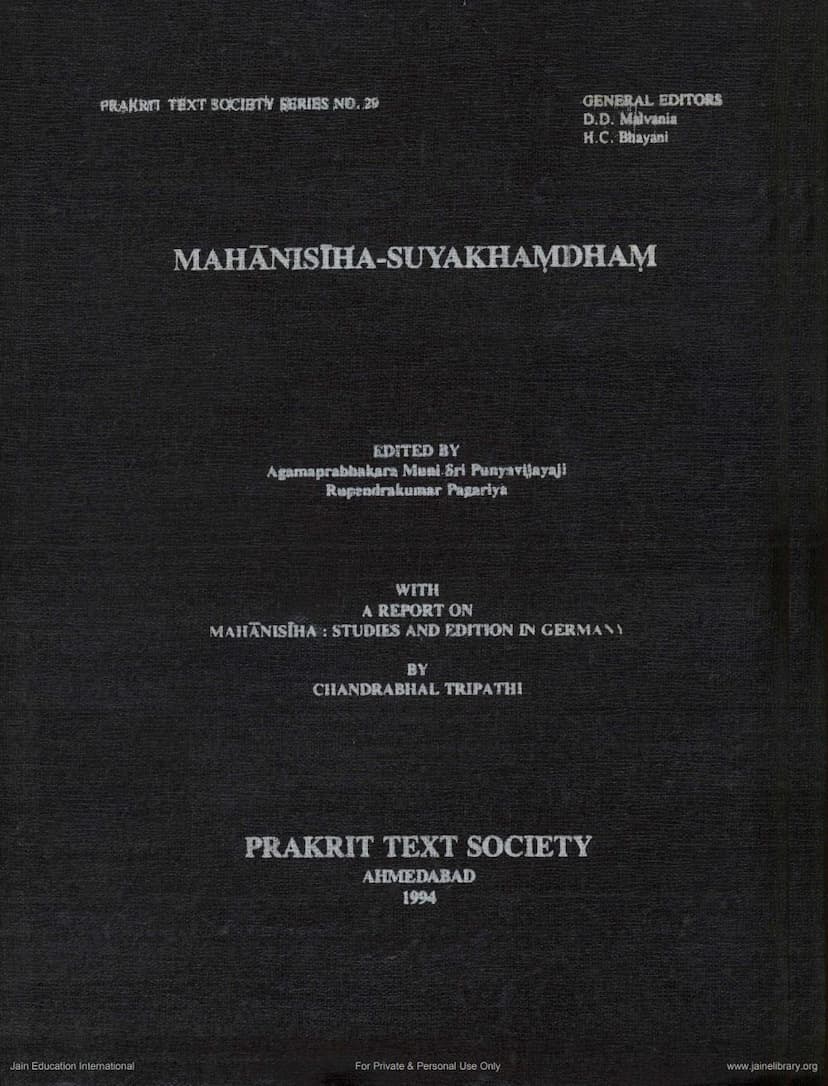Agam 39 Chhed 06 Mahanishith Sutra
Added to library: September 1, 2025

Summary
Here's a comprehensive summary of the Jain text "Agam 39 Chhed 06 Mahanishith Sutra," based on the provided information:
Title: Mahānisīha-suyakkhandha (Mahanishitha-Srutaskandha)
Authors/Editors: Ajramaprabhakar Muni Sri Punyav|jayaji, Rupendrakumar Pagariya, Dalsukh Malvania, H C Bhayani (General Editors), Chandrabhal Tripathi (Report on German Studies).
Publisher: Prakrit Text Society, Ahmedabad.
Publication Year: 1994
Overview:
The Mahānisīha-suyakkhandha (MNA), one of the Chedasūtras (texts on rules for monks and nuns) of the Jain Canon, is a significant and complex work that has been the subject of extensive scholarly study, particularly in Germany. This edition, compiled by Rupendrakumar Pagariya and incorporating a detailed report on German scholarship by Chandrabhal Tripathi, aims to provide a critical text and a comprehensive understanding of the Mahānisīha.
Key Themes and Content:
The Mahānisīha is known for its exhaustive treatment of Jain monastic discipline, ethical conduct, the consequences of actions (karma), and the path to liberation (moksha). It is characterized by:
- Discipline and Atonement: The text elaborates on the rules of conduct for monks and nuns and prescribes punishments for offenses against these vows, often presented through question-and-answer formats and illustrative legends.
- Confession and Penance: A central theme is the importance of confession (alocana) and repentance (pratikramaṇa) for purification and spiritual progress. It details various types of sins, their consequences, and the methods of atonement.
- Karma and Consequences: The Mahānisīha delves deeply into the workings of karma, explaining how actions lead to suffering or liberation, with numerous examples and astronomical figures illustrating the duration of existences.
- Monastic Life and Gachchhas: It discusses the ideal monastic life, the qualities of a virtuous monk and nun, the structure and importance of Gachchhas (monastic communities), and the role of the teacher (guru).
- Legends and Narratives: The text is rich with stories and legends that illustrate its teachings. These narratives, while sometimes considered late or recasted elements, serve to impart moral and ethical lessons.
- Pancha-Mangala: The five sacred formulas (Namo Arihantanam, Namo Siddhanam, Namo Ayariyāṇam, Namo Uvajjhāyānam, Namo Loe Savva-Sāhūṇam) are discussed in detail as the core of auspiciousness and spiritual practice.
- Controversial Elements: The Mahānisīha contains elements that have led to its classification as apocryphal by some Jain traditions. These include tantric influences, references to certain practices, and a language and metric style that are sometimes considered degenerate or inconsistent with the older canonical texts.
- Critique of Bad Monks (Kusila): A significant portion of the text is dedicated to categorizing and describing various types of monks who deviate from the prescribed path, highlighting their wrong views and actions and their detrimental effects.
- Purity and Idealism: Despite the critiques, the text often emphasizes the ideal of unconditional devotion to monastic life and the immense spiritual gain achieved through sincere confession, equating it to absolute knowledge (kevala-jñāna).
Scholarly Context (Report by Chandrabhal Tripathi):
The accompanying report by Chandrabhal Tripathi provides a valuable overview of the extensive German scholarship on the Mahānisīha, focusing on the contributions of Albrecht Weber, Walther Schubring, Frank-Richard Hamm, and Jozef Deleu.
- Key German Contributions: The report details the seminal works of these scholars, including Schubring's initial study in 1918 and his later collaborative editions of various chapters of the Mahānisīha.
- Textual Criticism and Editions: The German scholars utilized various manuscripts to produce critical editions, highlighting variant readings and providing detailed analyses of the text's language, meters, and content.
- Linguistic Analysis: The language of the Mahānisīha is characterized as Jaina Māhārāṣṭri with influences of Ardhamāgadhi, marked by specific phonetic and morphological features.
- Metrical Structure: Studies indicate a reliance on Anuṣṭubh and Āryā meters, with observations on the author's occasional carelessness or deviation from metrical norms.
- Parallels and Chronology: The Mahānisīha shows numerous parallels with other Jain texts like the Gacchācāra and Upadeśamālā, suggesting it is chronologically earlier than these works. However, its exact dating remains challenging, with estimates placing its composition between 900 and 1200 AD, though main parts might be earlier.
- Authorship and Canonicity: The Mahānisīha is considered to be the work of a single, though unknown, compiler who drew from various sources. Its inclusion in the Jain Canon has been debated, and it is often regarded as apocryphal due to its language, content, and late date. The attempts to attribute its editing to prominent figures like Jinabhadra-gani or Haribhadra are considered improbable by scholars.
Significance:
This edition and the accompanying report contribute significantly to Jainology by making a crucial but often debated canonical text accessible with detailed scholarly analysis. It highlights the evolution of Jain monastic law and ethics, as well as the history of textual studies of Jain literature. The work provides insights into the philosophical and practical aspects of Jainism, offering guidance on ethical conduct, the path to liberation, and the deep philosophical underpinnings of the tradition.
In essence, the Mahānisīha-suyakkhandha is a foundational text in Jainism that provides a comprehensive, albeit complex and sometimes debated, framework for monastic life, ethical conduct, and the understanding of karma and liberation, underpinned by a rich tradition of scholarly investigation.